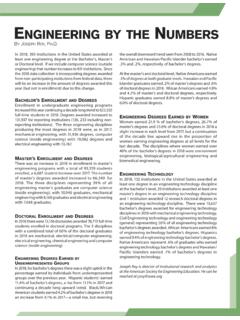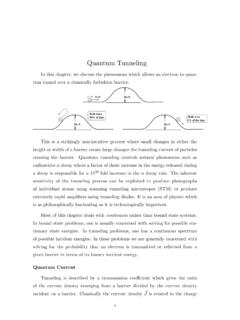Transcription of Risk Based Capital (RBC) - University of Illinois Urbana ...
1 Risk Based Capital (RBC) for an Illinois Based Insurance Company May 11, 2018 Undergraduate Researchers: Dong Shin (Bill) Seol, Qinxue Liu, Chuyi Ma, Kexin Liu Faculty Mentor: Klara Buysse University of Illinois at Urbana -Champaign 1 Table of Contents Introduction to RBC System 2 Risk Based Capital Ratio 5 Required Risk Based Capital 6 C-1 Asset Risk 7 C-2 Insurance Risk 12 C-3. Interest Rate Risk 13 C-4. Business Risk 17 Examples: Allstate Cooperation 20 Calculation of An Illinois - Based Company 21 Reference 23 2 Introduction to RBC System In the 1980s, hundreds of insurance industries went into insolvencies in North America. Policyholders, insurance companies employees, creditors and shareholders of companies, and the general public suffered from this insurance crisis. Economists and actuaries saw the weakness in the fixed Capital standards from this crisis, and decided to improve it. The fixed Capital standards required companies to hold minimum amount of Capital which equals to a fixed percentage ( percent for banks before the debt crisis) of their assets, regardless of risks these companies took in business.
2 RBC standard, created by National Association of Insurance Commissioners (NAIC), was therefore adopted in 1990s. It measures the minimum amount of Capital a company must hold Based on its level of risk. RBC standards make sure financial institutions keep sufficient amount of Capital on hand to support their operations and write coverage, and therefore protect shareholders, investors and clients of firms. Insurance companies use RBC formula to determine the minimum Capital they are required to hold to avoid regulator s intervention. The major risk factors RBC formula focus on are asset risk, underwriting risk, and other risks. The asset risk refers to the potential loss of investments on financial assets, such as lower investment performance in stock market relative to company s expectation. The underwriting risk refers to the risk that arises from insurance companies faulty underwriting, such as inaccurate assessments of an insurance policy.
3 Other risks include everything else, such as interest rate risk, which refers to the potential loss of a debtor s default on its financial obligations, requiring the insurance company to make the required payments. 3 Different types of insurance have different kind of risk factors, due to the specificities of these insurance businesses. NAIC developed distinct RBC models for four major insurance types: Life, Property/Casualty (P&C), Health, and Fraternal. Regulators use RBC standards to determine their intervention level on companies. There are four levels of regulatory action according to the RBC formula: - company action, - regulatory action, - authorized control and - mandatory control levels. If the company meets the RBC standard, NAIC regulators take no action; if not, the greater Capital deficiency this company has, the higher control level NAIC regulators will take on company. In this way, regulators ensure companies have adequate financial solvency under RBC system.
4 The levels of regulatory action triggered by the RBC ratio are as follows: NAIC only takes regulatory action when the ratio becomes less than 250%. If a company s RBC ratio is between 250% and 200%, and also fails the trend test (which measures past RBC ratio changes of the company), Company Action Level is triggered. If the ratio is between 200% and 150%, the company also triggers Company Action Level, and is required to submit a RBC plan to improve its RBC ratio into compliance. If the ratio is between 150% and 100%, the company triggers Regulatory Action Level, and is required to submit a corrective action plan. NAIC will perform examination or take regulatory action if the commissioner believe it is necessary. If the ratio is between 100% and 70%, the company triggers Authorized Control Level, and NAIC is authorized to take regulatory actions, such as rehabilitating or liquidating the insurer. If the ratio 4 is below 70%, the company triggers Mandatory Control Level, and NAIC is authorized to take regulatory control, including placing the insurer under regulatory supervision.
5 In our research project, we look at the basic concepts of the Risk- Based Capital (RBC) system, investigate RBC regulations, and look into discussions on how to improve companies RBC levels. We will then use the knowledge to determine the RBC ratio for a small life insurance company. The insurance products of this company will be backed by bonds and equities. This report will show our research progress on RBC system, including our knowledge on RBC regime, understanding of RBC formulas, and how we put this regulation into practice with an example. 5 Risk Based Capital Ratio RBC ratio is calculated by dividing the total adjusted Capital of the company by required Risk Based Capital . = Total Adjusted Capital (TAC) is the sum of un-invested surplus, Asset Valuation Reserve which is a liability found in annual statement that is created to buffer for losses1 (Equity and credit losses), and 50% of the insurer s dividend It can be seen as the total Capital of the company.
6 For example, a company with a 200% RBC ratio has Capital equal to twice its risk Based Capital . In the following sections, we will go into more detail about the Required Risk Based Capital . 1 2 6 Required Risk Based Capital Required Risk Based Capital is intended to calculate the minimum amount of Capital an insurance company should hold in order to not trigger regulatory action, meaning that the insurance company is solvent enough to do their regular insurance business. The Capital an insurance company should hold differs from the risks it is taken in its insurance and investment operations. For example, a company that is investing in risky assets will probably have to hold more Capital than a company that is investing in government bonds. RBC split the risks a company can take in four major classes for life insurers: - C-1 Asset risk, - C-2 Insurance risk, - C-3 Interest rate risk and - C-4 Business risk.
7 The Required Risk Based Capital can then be obtained through the formula: ( 4+ ( 1+ 3)2+ 22 )3 where C-1, C-2, C-3 and C-4 stands for the risk- Based Capital under that category. Note that this formula calculates the required Risk Based Capital at Company Action level, that is, when Risk Based Capital is twice of Total adjusted Capital . As one can see in the formula, the risks are adjusted for covariance. This is done in order to take into account the fact that all the four risks categories will not occur at the same time. In the following sections we will give an overview of the calculation of risk Based Capital for each risk. 3 7 C-1 Asset Risk C-1 Asset Risk measures the risk of default (of bonds and mortgage) or decrease in the value of the assets (stocks) insurers hold in their investing portfolio. RBC for Asset risk is calculated by multiplying different risk factors with different types of investments, including bonds, stocks, mortgages, real estate, and other long term assets and summing up the terms.
8 Certain types of assets will need an adjustment Based on the size of portfolio. Let s start with bonds. US government bonds have a risk factor of 0. C-1 risk only measure the default risk of bonds, and the likelihood of default of a government bond is nearly zero, because the government may fall behind the repayment of the bonds only if the nation is under severe financial deficit. Corporate issued bonds are classified into six SVO levels, and risk factors are related to the rating of the bonds. To classify the bonds into the different classes, one can obtain the ratings from Standard and. The following table shows the conversion and risk factors of bonds with different S&P ratings SVO ratings Risk factor AAA, AA+, AA-, A+, A, A- Class 1 BBB+, BBB, BBB- Class 2 BB+, BB, BB- Class 3 B+, B, B- Class 4 CCC+, CCC, CCC- Class 5 CC, C, D Class 6 4 8 Another consideration to calculate the risks for bonds is diversification.
9 A well-diversified portfolio with a large number of different issuer of bonds is considered less risky than a portfolio with fewer bond issuers. The adjustment factors are shown in the table below. Number of issuers factor First 50 Next 50 Next 300 Above 400 Let s illustrate the calculation of C-1 Asset risk for bonds by means of an example. Assume an investment portfolio with $1,000 of 30 years US government bonds, $1,000 of Bank of America Bonds with S&P rating of A, $1,000 of Rogers Communications Inc. bonds with S&P rating of BBB+. The total number of bond issuers here is 3. Pre-adjusted risk = $1,000 * 0 + $1,000 * + $1,000 * = $ Adjustment: $ * = $34 C-1 bonds risk Capital = $34 This means the insurer who invested in the above bonds will need at least $34 in equity to stay at non action level according to NAIC regulation on RBC. NAIC has proposed changes to the calculation of C-1 Asset risk for fixed income investments since 2015, by expanding the existing 6 NAIC classes to 20.
10 That is, every ratings from Standard and Poor s will get a different risk factor from NAIC. For example, the original NAIC class 1 bonds contains Standard and Poor s rating from AAA to A-, all getting a risk factor of Under the new proposal, an S&P rating of AAA is equivalent to NAIC rating of 9 1-A, with a risk factor of An S&P AA- bond will be classified as NAIC 1-D bond, and the risk factor is A reason for proposal of the new granular is that insurers has the incentive to invest in higher return bonds rather than the higher rating An investment of AAA bonds requires the same risk Based Capital as investing in A- bonds, while A- bonds has higher return rates as well as higher default risks. The current NAIC classification does not reflect such differences, and the required risk Based Capital can be insufficient for the insurers to stay solvent. The proposal can better eliminate the probability of insolvency by pressurize insurers to redesign their investment portfolios, optimizing the return and minimizing the risks on the investments.

